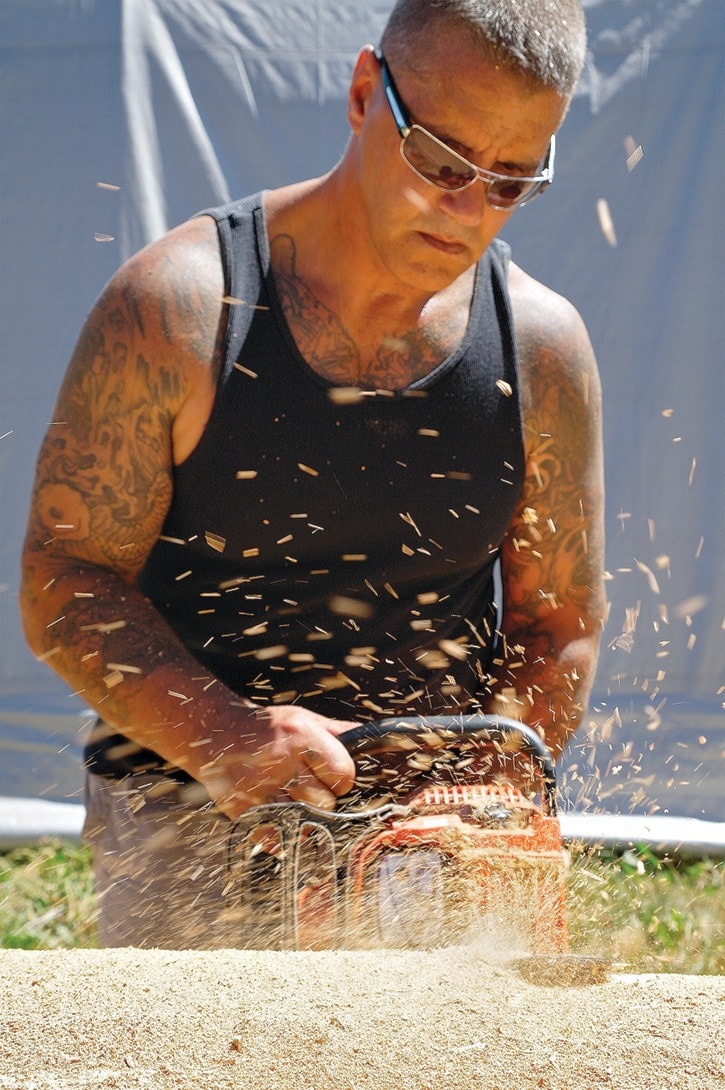arving is helping former Nanaimo Correctional Centre inmate find a path through life that has eluded him for more than two decades.
Richard Carlton, 47, was released from Guthrie House Therapeutic Community in June, but left something of himself behind for the facilities residents and staff, a yellow cedar totem pole depicting 14 characters that represent the journey through addiction recovery.
Guthrie House Therapeutic Community, which operates at Nanaimo Correctional Centre, is a self-contained, 65-bed facility that combines work, treatment, counselling and behavioural modelling to help keep inmates recovering from addiction out of the prison system. It is the only facility of its kind in Canada.
“I’ve been in prison, off and on, for over 25 years,” Carlton said. “It’s hard to explain addiction. It’s kind like when you were a kid at home and there are so many doors in the house. You look out those doors and you can go through them and each door is an opportunity, but in addiction you kind of close all those doors behind you and you’re trapped in one room and that’s all you know.”
Carlton, who was born in Nova Scotia and grew up in Victoria, spent time in provincial and federal prison for offences that included breaking and entering, drug dealing and armed robbery to support his addiction to heroin and cocaine.
When he wasn’t in prison, Carlton worked as a professional tattoo artist, an art form he practised for 30 years.
“I got out of the pen about seven years ago and moved to White Rock,” Carlton said. “I thought I could do it there. I was making really good money. I was tattooing, but there’s drugs and if you don’t have that support around you ... I’m not putting down tattooing. I’ve met a lot of wonderful people through that profession, but for me, being that addictive personality? Not good for me.”
Over the years Carlton learned to carve, studied with master carvers and eventually became a master carver himself, but he was also going through the revolving door of addiction which would land him back in prison where addiction treatment and methadone programs failed to provide the tools he needed to turn his life around.
By the time he was arrested again he was using heavily, even though he was on methadone.
“I came back in. I was on 120 mils of methadone,” Carlton said. “I cut it cold turkey. I was 46 at the time. I thought, ‘I can’t do this anymore. I’m going to end up dying.’ It’s amazing I’m not dead now. A lot of my friends have died over the years.”
Carlton said Crown prosecutors wanted 36 months, which would have sent him to a federal penitentiary. He would have carved in there – most of his carvings, including a pair of poles carved for a recovery centre at William Head, have been completed in prison – but he said he would have likely continued using drugs as well.
This time a judge ordered Carlton to 18 months at Guthrie House, which forces residents to confront their addictions, decisions and behaviours in their lives that led them to where they are, teaches them to be accountable to themselves and others, and to experience and deal with their full range of emotions.
“It’s a blessing in disguise,” Carlton said. “It might be prison, but it’s saving lives.”
Carlton continued carving at Guthrie House, starting with a pair of masks.
The carving lead to Carlton being made the facility activities coordinator who creates new activities and jobs for other residents. Carlton took charge of the wood shop and, at the suggestion of one of the guards, asked for a log to be brought in to be carved.
The log arrived.
“It was pretty rotten log – pretty punky inside – but I said, ‘Hey I’ll do something with it,’” Carlton said. “So I designed the pole around the rot in it, which is kind of like our lives, right? … I wanted to design it as story of recovery and inspire guys. It’s a start for me, but it could be a start for a lot of other guys. Once you get over addiction you start to look at yourself and start to need to do things. Something therapeutic. Something that will inspire you to carry on in your life.”
The pole was raised on the correctional centre grounds July 4. Carlton has since been commissioned to design and carve a protection totem pole for Tillicum Lelum’s facility on Haliburton Street. The pole, being carved from a 370-year-old red cedar log, will depict a bear, wolf, eagle and watchman.
“It’s really neat the doors it’s opening for me, as long as I stay on the same path,” Carlton said. “My life actually has a path now.”
